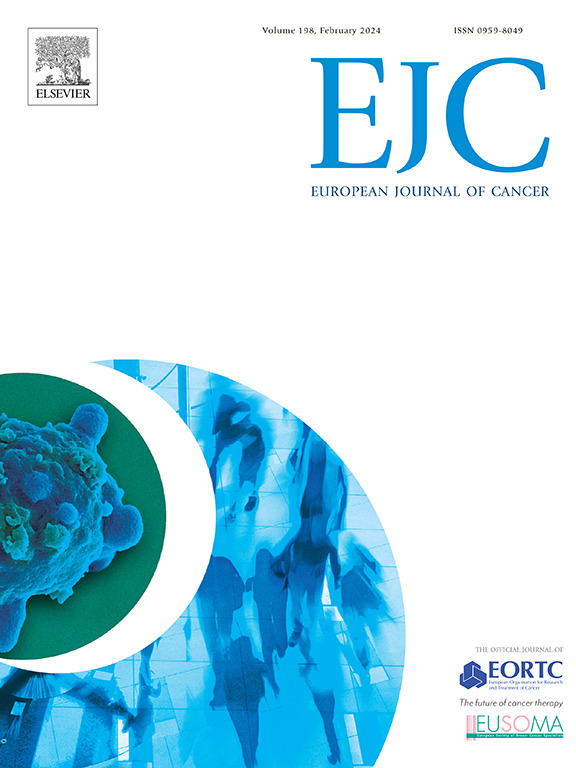橄榄油消费与乳腺癌风险:Moli-sani研究的前瞻性结果,以及对观察性研究和随机临床试验的系统回顾
IF 7.6
1区 医学
Q1 ONCOLOGY
引用次数: 0
摘要
背景:乳腺癌(BC)是全球女性癌症相关死亡的主要原因。富含单不饱和脂肪和多酚的橄榄油与降低BC风险有关,但流行病学证据仍然有限。本研究在意大利成年女性中调查了橄榄油消费与BC风险之间的关系,并对这种关系进行了系统回顾。方法对Moli-sani研究(2005-2010)的11442名女性(平均年龄54.7 ± 11.6岁)进行纵向分析。Cox比例风险模型用于估计与橄榄油消费相关的BC风险。通过检索截至2024年10月的Scopus、EMBASE、PubMed和MEDLINE数据库,对观察性研究和随机对照试验进行系统评价。结果与较低的橄榄油摄入量(≤2 tbsp./d)相比,总体、绝经前和绝经后BC中最高摄入量(3 tbsp./d)的多变量调整hr分别为0.71(95 %CI 0.48-1.05)、0.80(95 %CI 0.28-2.28)和0.70(95 %CI 0.46-1.08)。增加1汤匙。每日摄入橄榄油与较低的ER和PR乳腺癌风险相关(HR=0.32;95 %CI 0.13-0.77),特别是ER病例(HR=0.32;95年 %可信区间0.15 - -0.69);此外,与食用橄榄油最少的人群相比,食用橄榄油最多的人群发生HER2 - BC的风险较低(HR=0.54;95 %可信区间0.31 - -0.96)。系统评价包括13项观察性研究(11项病例对照研究和2项前瞻性研究)和1项随机对照试验。虽然病例对照研究和随机对照试验表明橄榄油的食用有保护作用,但纵向研究报告没有关联。Moli-sani研究的结果表明,橄榄油的摄入量与激素受体阴性乳腺癌(尤其是ER亚型)的风险呈负相关,但对总体乳腺癌风险尚无定论。系统评价显示,病例对照研究更多地报告了保护性关联,而前瞻性研究并未一致支持这一发现。本文章由计算机程序翻译,如有差异,请以英文原文为准。
Olive oil consumption and risk of breast cancer: Prospective results from the Moli-sani Study, and a systematic review of observational studies and randomized clinical trials
Background
Breast cancer (BC) is the leading cause of cancer-related death among women worldwide. Olive oil, rich in monounsaturated fats and polyphenols, has been linked to a reduced BC risk, but epidemiological evidence remains limited. This study examined the association between olive oil consumption and BC risk in a large cohort of adult Italian women and conducted a systematic review on this association.
Methods
Longitudinal analyses were performed on 11,442 women (mean age 54.7 ± 11.6 years) enrolled in the Moli-sani Study (2005–2010). Cox proportional hazard models were used to estimate BC risk in relation to olive oil consumption. A systematic review was conducted by searching Scopus, EMBASE, PubMed, and MEDLINE databases up to October 2024 for observational studies and RCTs.
Results
Compared with lower olive oil consumption (≤2 tbsp./day), multivariable-adjusted HRs associated with highest intake (>3 tbsp./d) for overall, premenopausal, and postmenopausal BC were 0.71(95 %CI 0.48–1.05), 0.80 (95 %CI 0.28–2.28), and 0.70 (95 %CI 0.46–1.08), respectively.
An increase of 1-tbsp./d of olive oil was associated with a lower risk of ER![]() and PR
and PR![]() breast cancers (HR=0.32; 95 %CI 0.13–0.77), particularly ER
breast cancers (HR=0.32; 95 %CI 0.13–0.77), particularly ER![]() cases (HR=0.32; 95 %CI 0.15–0.69); additionally, a lowered hazard of HER2– BC incidence was observed at highest consumption of olive oil compared to the bottom category (HR=0.54; 95 %CI 0.31–0.96).
cases (HR=0.32; 95 %CI 0.15–0.69); additionally, a lowered hazard of HER2– BC incidence was observed at highest consumption of olive oil compared to the bottom category (HR=0.54; 95 %CI 0.31–0.96).
The systematic review included 13 observational studies (11 case-control and 2 prospective) and 1 RCT. While case-control studies and the RCT suggested a protective effect associated with olive oil consumption, longitudinal studies reported no association.
Conclusions
Findings from the Moli-sani Study suggest an inverse association between olive oil consumption and the risk of hormone receptor-negative breast cancers, particularly ER![]() subtype, while results were inconclusive for overall BC risk. The systematic review revealed that case-control studies more frequently reported a protective association, whereas prospective studies did not consistently support this finding.
subtype, while results were inconclusive for overall BC risk. The systematic review revealed that case-control studies more frequently reported a protective association, whereas prospective studies did not consistently support this finding.
求助全文
通过发布文献求助,成功后即可免费获取论文全文。
去求助
来源期刊

European Journal of Cancer
医学-肿瘤学
CiteScore
11.50
自引率
4.80%
发文量
953
审稿时长
23 days
期刊介绍:
The European Journal of Cancer (EJC) serves as a comprehensive platform integrating preclinical, digital, translational, and clinical research across the spectrum of cancer. From epidemiology, carcinogenesis, and biology to groundbreaking innovations in cancer treatment and patient care, the journal covers a wide array of topics. We publish original research, reviews, previews, editorial comments, and correspondence, fostering dialogue and advancement in the fight against cancer. Join us in our mission to drive progress and improve outcomes in cancer research and patient care.
 求助内容:
求助内容: 应助结果提醒方式:
应助结果提醒方式:


